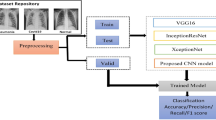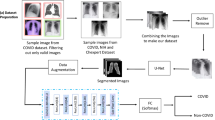Abstract
Most challenging yet, the need of the hour is accurate diagnosis of COVID-19, as the Coronavirus cases are increasing drastically day-by-day. Ceaseless efforts by the researchers and innovators have led to the development of several diagnostic models based on Deep Learning for effective diagnosis of COVID-19. However, the Deep Learning techniques that have been developed so far, fail to address major challenges such as overfitting, stability, computation overhead due to the usage of the massive volume of parameters and problems associated with the multi-class classification. Also in the medical perspective, researchers often suffer to identify the infinitesimal difference that exists in the radiographic images among the several lung diseases which makes the decision-making process difficult. Thus, to curb the crisis and to provide promising solutions & expertise for accurate diagnosis, this paper presents a novel lightweight multi-class multi-label COVID-19 detection model to assist physicians with greater ease to fight against this pandemic situation. Radiographic images are pre-processed using Contrast Limited Adaptive Histogram Equalization (CLAHE) and classified using novel Stacked Dark COVID-Net. The proposed model is validated using chest X-ray images and the results confirm the efficacy of the proposed model in terms of classification accuracy, sensitivity, specificity and stability.
Access this chapter
Tax calculation will be finalised at checkout
Purchases are for personal use only
Similar content being viewed by others
References
COVID-19 Coronavirus Pandemic, 09:23 GMT. https://www.worldometers.info/coronavirus/. Accessed 24 July 2021
Messages and Actions. https://www.who.int/docs/default-source/coronaviruse/key-messages-and-actions-for-covid-19-prevention-and-control-in-schools-march-2020.pdf
Ozturk, T., Talo, M., Yildirim, E.A., Baloglu, U.B., Yildirim, O., Rajendra Acharya, U.: Automated detection of COVID-19 cases using deep neural networks with X-ray images. Comput. Biol. Med. 121, 103792 (2020). https://doi.org/10.1016/j.compbiomed.2020.103792
Symptoms of Coronavirus. https://www.cdc.gov/coronavirus/2019-ncov/symptoms-testing/symptoms.html
Lau, S.K.P., Che, X., Woo, P.C.Y., Wong, B.H.L., Chan, K., Peiris, J.S.M.: SARS Coronavirus detection methods. Emerg. Infect. Dis. 11, 7–10 (2005)
McCall, B.: COVID-19 and artificial intelligence: protecting health-care workers and curbing the spread. Lancet Digit. Heal. 2, e166–e167 (2020). https://doi.org/10.1016/s2589-7500(20)30054-6
Lee, E.Y.P., Ng, M.Y., Khong, P.L.: COVID-19 pneumonia: what has CT taught us? Lancet Infect. Dis. 20, 384–385 (2020). https://doi.org/10.1016/S1473-3099(20)30134-1
Chan, J.F.W., et al.: A familial cluster of pneumonia associated with the 2019 novel coronavirus indicating person-to-person transmission: a study of a family cluster. Lancet 395, 514–523 (2020). https://doi.org/10.1016/S0140-6736(20)30154-9
Gauthama Raman, M.R., Somu, N., Kirthivasan, K., Liscano, R., Shankar Sriram, V.S.: An efficient intrusion detection system based on hypergraph - genetic algorithm for parameter optimization and feature selection in support vector machine. Knowl.-Based Syst. 134, 1–12 (2017). https://doi.org/10.1016/j.knosys.2017.07.005
Zu, Z.Y., et al.: Coronavirus disease 2019 (COVID-19): a perspective from China. Radiology 2019, 200490 (2020). https://doi.org/10.1148/radiol.2020200490
Sirazitdinov, I., Kholiavchenko, M., Mustafaev, T., Yixuan, Y., Kuleev, R., Ibragimov, B.: Deep neural network ensemble for pneumonia localization from a large-scale chest X-ray database. Comput. Electr. Eng. 78, 388–399 (2019). https://doi.org/10.1016/j.compeleceng.2019.08.004
Bhandary, A., et al.: Deep-learning framework to detect lung abnormality – a study with chest X-Ray and lung CT scan images. Pattern Recognit. Lett. 129, 271–278 (2020). https://doi.org/10.1016/j.patrec.2019.11.013
Kumar, A., Tiwari, P., Kumar, S., Gupta, D., Khanna, A.: Identifying pneumonia in chest X-rays: a deep learning approach. Measurement 145, 511–518 (2019). https://doi.org/10.1016/j.measurement.2019.05.076
Behzadi-Khormouji, H., et al.: Deep learning, reusable and problem-based architectures for detection of consolidation on chest X-ray images. Comput. Methods Programs Biomed. 185, 105162 (2020). https://doi.org/10.1016/j.cmpb.2019.105162
Kumar, A., Tripathi, A.R., Satapathy, S.C., Zhang, Y.-D.: SARS-Net: COVID-19 detection from chest X-rays by combining graph convolutional network and convolutional neural network. Pattern Recogn. 122, 108255 (2021). https://doi.org/10.1016/j.patcog.2021.108255
Vinod, D.N., Jeyavadhanam, B.R., Zungeru, A.M., Prabaharan, S.R.S.: Fully automated unified prognosis of Covid-19 chest X-ray/CT scan images using Deep Covix-Net model. Comput. Biol. Med. 136, 104729 (2021). https://doi.org/10.1016/j.compbiomed.2021.104729
Song, Y., et al.: Deep learning enables accurate diagnosis of novel coronavirus (COVID-19) with CT images. medRxiv, 2020.02.23.20026930 (2020). https://doi.org/10.1101/2020.02.23.20026930
Barstugan, M., Ozkaya, U., Ozturk, S.: Coronavirus (COVID-19) classification using CT images by machine learning methods, pp. 1–10 (2020)
Chen, X., Yao, L., Zhang, Y.: Residual attention U-Net for automated multi-class segmentation of COVID-19 chest CT images, vol. 14, pp. 1–7 (2020)
Hemdan, E.E.-D., Shouman, M.A., Karar, M.E.: COVIDX-Net: a framework of deep learning classifiers to diagnose COVID-19 in X-Ray images (2020)
Wang, L., Wong, A.: COVID-Net: a tailored deep convolutional neural network design for detection of COVID-19 cases from chest X-Ray images, pp. 1–12 (2020)
Apostolopoulos, I.D., Mpesiana, T.A.: Covid-19: automatic detection from X-ray images utilizing transfer learning with convolutional neural networks. Phys. Eng. Sci. Med. 43(2), 635–640 (2020). https://doi.org/10.1007/s13246-020-00865-4
Narin, A., Kaya, C., Pamuk, Z.: Automatic Detection of Coronavirus Disease (COVID-19) Using X-ray Images and Deep Convolutional Neural Networks (2020)
Kumar, P., Kumari, S.: Detection of coronavirus Disease (COVID-19) based on Deep Features (2020). https://doi.org/10.20944/preprints202003.0300.v1
de Moura, J., Novo, J., Ortega, M., Detection, P.D., Imaging, X.: Fully automatic deep convolutional approaches for the analysis of Covid-19 using chest X-ray images. Medrxiv, pp. 1–13 (2020). https://doi.org/10.1101/2020.05.01.20087254
Zuiderveld, K.: Contrast limited adaptive histogram eqn. Graph. Gems. 474–485 (1994)
Mangeruga, M., Bruno, F., Cozza, M., Agrafiotis, P., Skarlatos, D.: Guidelines for underwater image enhancement based on benchmarking of different methods. Remote Sens. 10, 1–27 (2018). https://doi.org/10.3390/rs10101652
Bendjillali, R.I., Beladgham, M., Merit, K., Taleb-Ahmed, A.: Improved facial expression recognition based on DWT feature for deep CNN. Electron. 8, 324 (2019). https://doi.org/10.3390/electronics8030324
Redmon, J., Farhadi, A.: YOLO9000: better, faster, stronger. In: Computer Vision, pp. 7263–7271
Oh, Y., Park, S., Ye, J.C.: Deep learning COVID-19 features on CXR using limited training data sets. IEEE Trans. Med. Imaging 39, 1 (2020). https://doi.org/10.1109/tmi.2020.2993291
Cohen, J.P., Morrison, P., Dao, L.: COVID-19 image data collection. https://github.com/ieee8023/covid-chestxray-dataset
RSNA Pneumonia Detection Challenge. https://www.kaggle.com/c/rsna-pneumonia-detection-challenge
Acknowledgements
This work was supported by The IBM Shared University Research Grant 2017, New York, USA. The authors would like to thank Vigneswaran C. for his valuable inputs in drafting the manuscript.
Author information
Authors and Affiliations
Corresponding author
Editor information
Editors and Affiliations
Ethics declarations
Conflict of Interest
All the authors declare that they do not have any conflict of interest.
Rights and permissions
Copyright information
© 2022 Springer Nature Switzerland AG
About this paper
Cite this paper
Anila Glory, H., Meghana, S., Kesav Kumar, J.S., Shankar Sriram, V.S. (2022). Stacked Dark COVID-Net: A Multi-class Multi-label Classification Approach for Diagnosing COVID-19 Using Chest X-Ray Images. In: Santosh, K., Hegadi, R., Pal, U. (eds) Recent Trends in Image Processing and Pattern Recognition. RTIP2R 2021. Communications in Computer and Information Science, vol 1576. Springer, Cham. https://doi.org/10.1007/978-3-031-07005-1_7
Download citation
DOI: https://doi.org/10.1007/978-3-031-07005-1_7
Published:
Publisher Name: Springer, Cham
Print ISBN: 978-3-031-07004-4
Online ISBN: 978-3-031-07005-1
eBook Packages: Computer ScienceComputer Science (R0)




